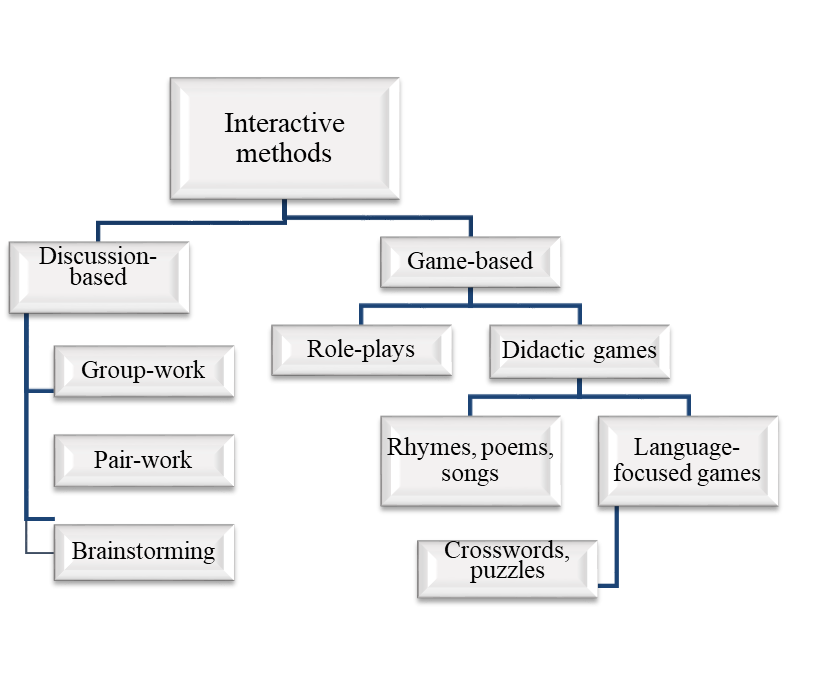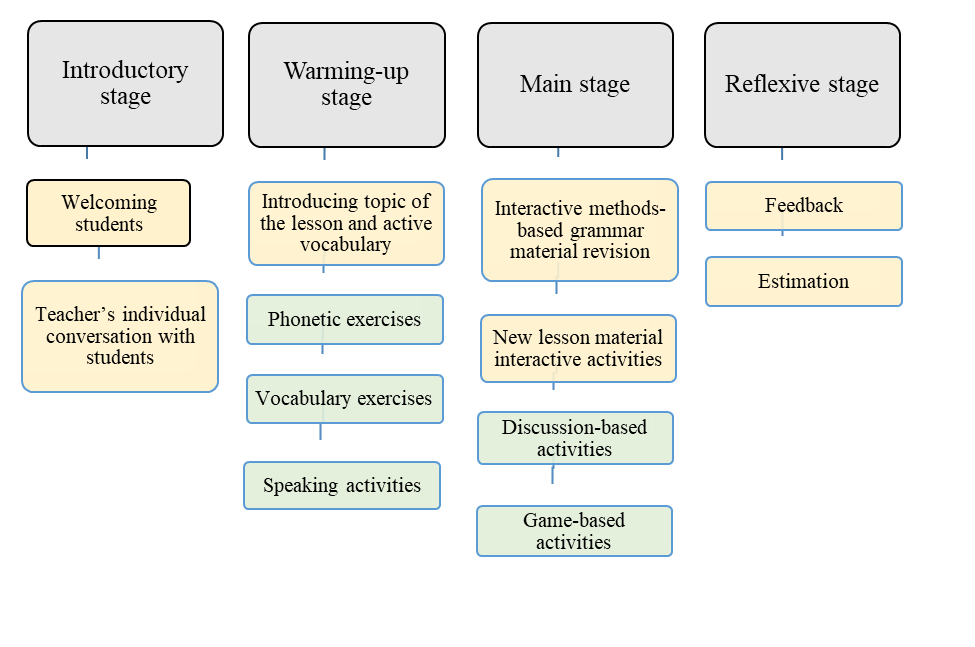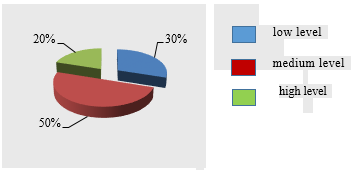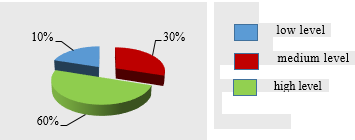Abstract
Teaching young learners is always a challenge and requires new sophisticated approaches and solutions in terms of developing speaking skills. The article aims to analyse the ways interactive technologies influence motivation and encourage young learners to speak fluently. To achieve it, emotional and psychological difficulties students experience are to be taken into consideration. In this respect, IM are vital and need further development to be applied in educational process. To boost students’ speaking skills, to help them overcome psychological barrier a new pattern of teaching-learning process needs to be worked out. The article presents the developed and implemented an interactive activity-based model of speaking practice. For the experimental base of the study two groups of 20 young learners aged 8-10 participated in the experiment. The article describes the results of the experimental study and one of the lesson patterns that was developed by the authors. IM proved to be a very efficient motivating tool to acquire speaking skills in a more student friendly educational environment. The results of the study may be useful for teachers and tutors working with this age group. To achieve success in teaching-learning process a special lesson pattern should be developed. The interactive method-based teaching pattern, suggested in the article, increased young learners’ motivation, broadened their horizon, helped to create comfortable educational environment and resulted in their ability to work independently and think critically.
Keywords: Speaking skillsyoung learnersinteractive methods
Introduction
Nowadays teachers and educators widely discuss the necessity of reviewing and updating the pedagogies used all over the globe. Though the increasing number of schools is reported to be innovating, “schools remain largely seen as very resistant places for innovation” (Peterson, Dumont, Lafuente, & Law, 2018, p. 4).
That is why, it is important to underline that the so-called “joy of teaching” and “joy of learning” combined are the key principles in creating positive educational environment (UNICEF, 2006, p. 23).
Thus, child-centered and learner-friendly educational environment is becoming a great priority as “interactive methodologies make learning enjoyable and exciting to students and improve their retention, participation and performance” (UNICEF, 2006, p. 23). Interactive methods help teachers to encourage “greater attentiveness, interest and responsiveness” in children while improving their language skills (UNICEF, 2006, p. 23).
Developing young learners’ speaking skills deals with boosting their verbal and thinking capacity and interest to language and cultural diversity.
The effectiveness of teaching young learners correlates with a teacher’s ability to resort to various strategies among which interactive cognitive strategies prevail since they provide proper acquisition of speaking skills.
The major principle of teaching speaking proves to be improvement of young learners’ listening and speaking skills to be involved in the process of communication.
It should be noted that a teacher working with children deal with so-called mixed-ability groups. That is why a teacher has to take into consideration multiple intelligences of students: different types of personality, thinking, scope of attention, the ability to perceive and process information (Korovina, Pushkina, & Krivoshlykova, 2017, p.10).
Apparently, teaching young learners requires special approaches to planning and organizing the educational process. Experts highlight “meaningful practice” which suggests “an activity where language control is still provided but where students are required to make meaningful choices when carrying out practice” (Richards, 2006, p.16). Buhrow and Garcia (2006) recognize, that meaningful practice results in meaningful communication, because for kids, “learning is all about exploring their passions and interests” (p. VIII).
In this respect, we believe interactive methods (IMs) to be one of the most effective tools. It helps to create comfortable educational environment, smooth psychological barriers and it results in stimulating young learners’ activities. In the framework of IMs, students are encouraged by the teacher to search for information independently, to interact with readiness and enthusiasm in communicative situations.
The flowchart below (Figure

On this account, Carmen Becker and Jana Roos (2016) stick to the point that “creative speaking activities in the young learners’ classroom act can provide a springboard for speaking in the early language classroom” (p.21).
To promote students’ communicative competence and to make lessons more purposeful and interactive such activities as simulation and role-play are to be employed as they contribute to students’ considering themselves as much real as possible (Ahmed & Pawar, 2018, p.309).
Foreign language teachers should be accurate in designing learner-friendly, “supportive and nurturing” educational environment and help pupils “become confident and enthusiastic communicators” (“Five Components …”, 2014, p.42).
Problem Statement
Teaching young learners is always a challenge and requires new sophisticated approaches and solutions in terms of developing speaking skills. А more student friendly educational environment is to be created to provide efficiency and boost kids’ motivation in learning foreign languages.
Research Questions
1. To what extent do interactive methods influence the young learners’ motivation?
2. What are key principles of speaking skills-focused lesson planning?
Purpose of the Study
The article aims to analyze the ways interactive technologies influence motivation and encourage young learners to speak fluently. To achieve it, emotional and psychological difficulties students experience are to be taken into consideration. In this respect, IM are vital and need further development to be applied in educational process.
Research Methods
To achieve the aim of the research we employed such methods as experimental study, empirical observation.
The sample took place in a Moscow-based school, included two teachers and twenty students aged 8-9 divided into two groups.
In the framework of the experimental study, we worked out an interactive activity-oriented pattern of a lesson focused on speaking practice.
The experimental study lasted three months with sixty-minute lessons three times a week.
During the lessons the teachers used verbal, auditory, visual, audio-visual means of teaching. Each lesson consisted of four basic stages according to which the interactive activities were designed. Moreover, the educational process suggested the employment of multimedia technologies as a smart board, computers, etc.
Figure

As it is seen from the flowchart, the interactive activities predominate in the main stage. Indeed, according to Stinson and Winston (2011), for example, role-plays and dramatizing during a foreign language lesson motivate young learners and contribute “to a range of positive results including improved spontaneity, fluency, articulation and vocabulary” (p.482). There’s an extensive range of interactive activities. However, in the article we focus on some of them which proved to be the most effective and resultative ones.
For example, to revise the grammar construction
-Are there any animals in the picture?
-No theren’t any animals in the picture/ Yes, there’s one animal/two animals in the picture.
-Is there a domestic/wild animal in the picture? /Is there a cat or a dig in the picture? …
Then, the students are supposed to change their cards and roles and do the same tasks.
There’s another amusing task young learners are enthusiastic about is «I go shopping» role-play. According to the rules of the play they use grammar and speech patterns of a lesson:
One of the students is a shop-assistant, others are customers. The list of the goods can be provided on the board or cards. It’s very important that the teacher should not interrupt and interfere in the role-play since the children are excited about the play, overcome psychological barrier and are not afraid to make mistakes. Because by memorizing mini-dialogs and speech patterns, “the chances of making mistakes are minimized” (Richards, 2006, p.4). At the same time the teacher writes down their mistakes to discuss them at the following stage.
As for discussion-based activities, they help students to acquire confidence in speaking. As a rule, eight-year-old kids are not used to expressing their opinion. That’s why this task is a good chance for them to chat about the things they are really fond of. However, some students feel too shy to speak due to different reasons, in this case they are given a book or cartoon character to play they might like. To make the most of this type of activity the teacher must be careful to choose topics appropriate for the age (“Hobbies”, Friendship”, “My family”, “Books in my life”, “Sports”, etc). To encourage their creativity sometimes it is quite useful to resort to so-called mind-maps. For example, for the topic “My favourite animal” students can be given the following mind-map (see Figure

If students’ speech is not fluent enough, they may be given some statements by the teacher or other students to express their agreement or disagreement. Moreover, time management is critical because young learners are not experienced enough to perceive time.
Furthermore, brainstorming proved to be very resultative. On the one hand, it meets kids’ desire to play, on the second hand, it provokes their creative thinking and expands their active vocabulary. The experiment showed that
The reflexive stage plays no less crucial role in developing speaking skills. The teacher summarizes the aims reached during the lesson, giving the students opportunity to share their impressions on activities (games, puzzles, brainstorming, etc.). It is important to highlight that students’ comments, ideas, or criticism should not be ignored by planning the following lesson. But it doesn’t mean that the teacher changes the structure of a lesson, on the contrary, he/she tries to be more flexible and uses activities which facilitate learning process and boost students’ motivation and creativity.
Findings
The study was conducted in several phases.
During

The segments of the pie chart show percentage and three levels of the kids’ speaking skills. The vast majority of young learners face serious difficulties in speaking.
During

The outcome of the result was quite positive. IM proved to be a very efficient motivating tool to acquire speaking skills in a more student friendly educational environment. Interactive methods being so-called “chocolate-covered” broccoli” “reinforce traditional teaching” (Paniagua & Istance, 2018, p. 93).
The kids demonstrated less shyness but more enthusiasm in expressing their own thoughts and ideas in the framework of a school lesson. Despite the mistakes made during the lessons, the students kept their desire to be involved in the educational process. At the same time the teachers enjoyed working according to this pattern and emphasized the boost of the kids’ motivation to study English.
Conclusion
To achieve success in teaching-learning process a special lesson pattern was developed. The interactive method-based teaching pattern, suggested in the article, increased young learners’ motivation, broadened their horizon, helped to create comfortable educational environment and resulted in their ability to work independently and think critically.
Teachers should be ready “to prepare learner-friendly lessons with thematic approaches for more holistic learning” (UNICEF, 2006, p. 23). While planning and organizing a lesson, a teacher should keep in mind some key principles, which help to make young learners’ teaching speaking more resultative:
language immersion;
young learner friendly educational environment;
awareness of different types of personality and psychological peculiarities;
kids’ interaction and communication in class;
delicate mistakes correction and proper encouragement.
The study has shown that interactive methods prove to be one of the most effective tools in developing young learners’ speaking skills.
Acknowledgments
The publication has been prepared with the support of the “RUDN University Program 5-100”.
References
- Ahmed, S. T. S., & Pawar, S. V. (2018). Communicative competence in English as a foreign language: Its meaning and the pedagogical considerations for its development. The Creative Launcher, 2(4), 301-312.
- Becker, C., & Roos, J. (2016). An approach to creative speaking activities in the young learners’ classroom. Education Inquiry, 7(1), 27613.
- Buhrow, B., & Garcia, A. U. (2006). Ladybugs, Tornadoes, and Swirling Galaxies: English Language Learners Discover Their World Through Inquiry. Portsmouth, NH: Stenhouse Publishers.
- Five Components of Effective Oral Language Instruction: A Guide to the Teaching and Learning of Oral Language (2014). PDST. Dublin. Retrieved from https://pdst.ie/sites/default/files/Manual%20Oral%20Language.pdf
- Korovina, S., Pushkina, A., & Krivoshlykova, L. (2017). Effective Tools to Integrate Chinese Students into ESL Learning Process. The European Proceedings of Social & Behavioural Sciences, 31, 8-16.
- Paniagua, A., & Istance, D. (2018). Teachers as Designers of Learning Environments: The Importance of Innovative Pedagogies, Educational Research and Innovation. Paris: OECD Publishing.
- Peterson, A., Dumont, H., Lafuente, M., & Law, N. (2018). Understanding innovative pedagogies: Key themes to analyse new approaches to teaching and learning. OECD Education Working Papers, (172), 0_1-134. Retrieved from https://read.oecd-ilibrary.org/education/understanding-innovative-pedagogies_9f843a6e-en#page1
- Richards, J. C. (2006). Communicative Language Teaching Today. NY: Cambridge University Press.
- Stinson, M., & Winston, J. (2011). Drama education and second language learning: a growing field of practice and research. Research in Drama Education. Journal of Applied Theatre and Performance, 16(4), 479-488.
- UNICEF (2006). Child Friendly Schools Manual. Retrieved from https://www.unicef.org/publications/files/Child_Friendly_Schools_Manual_EN_040809.pdf
Copyright information

This work is licensed under a Creative Commons Attribution-NonCommercial-NoDerivatives 4.0 International License.
About this article
Publication Date
07 November 2019
Article Doi
eBook ISBN
978-1-80296-071-6
Publisher
Future Academy
Volume
72
Print ISBN (optional)
-
Edition Number
1st Edition
Pages
1-794
Subjects
Psychology, educational psychology, counseling psychology
Cite this article as:
Korovina, S., Pushkina, A., & Krivoshlykova, L. (2019). Interactive Methods In Developing Young Learners’ Speaking Skills. In P. Besedová, N. Heinrichová, & J. Ondráková (Eds.), ICEEPSY 2019: Education and Educational Psychology, vol 72. European Proceedings of Social and Behavioural Sciences (pp. 327-334). Future Academy. https://doi.org/10.15405/epsbs.2019.11.30

